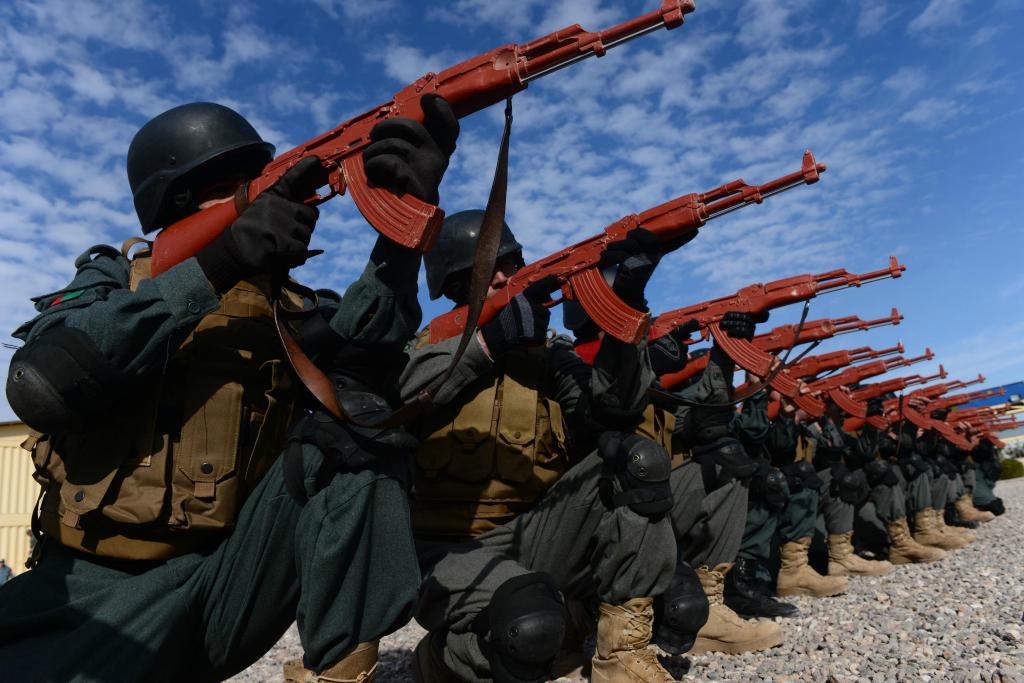US reconstruction aid for Afghanistan is focused on weapons; much is siphoned off by corruption
Afghan policemen perform a drill during exercises at a police training centre in Herat on January 27, 2015. The conflict against the Taliban still rages across Afghanistan, and an estimated 17,000 foreign soldiers will stay on to assist the local police and army, both of which face a major challenge as the international military presence declines.
PROVIDENCE — Since 2001, the United States has spent a staggering $107 billion on what is called the “reconstruction” of Afghanistan.
That might have been a worthwhile investment if it had all been focused on helping the Afghan people recover from years of war and build a just and sustainable social order. While the US and its allies can point to some successes in reducing infant mortality or raising school enrollment numbers in some regions, the aid has mostly under-delivered or even been counterproductive. Unless America’s basic approach to aiding that long-suffering country changes, no amount of money will bring success.
“Reconstruction” is a misleading label for what the United States has done in Afghanistan. About 70 percent of US aid has gone to paying, equipping and training the Afghan police and military and to counter-narcotics operations. Only the remainder has gone to promoting good governance, enhancing education or building roads and health care facilities.
Armies and police forces are essential institutions in a modern nation-state, but Afghanistan’s security apparatus is now grossly outsized. Afghanistan is awash in weaponry from US arms donations. Nearly 400,000 men, a significant proportion of the adult male population, are in uniform. This may count as a successful employment program, but true development would require more aid to promote agriculture and other productive enterprises—particularly ones that don’t leave women out.
Another problem has been the frequent mismatch between what the Afghan people say they want and what the US decides to give them. In part, this is the old story of ethnocentrism and hubris that has often dogged development aid. It also stems from the view, shared by American military commanders and the US Congress, that the way to turn the tide of war is to send most aid to regions and towns where the insurgency is strongest. Those areas, however, are not always the ones where humanitarian and development needs are most urgent.
Both our military and development aid have produced infrastructure and institutions that are wildly out of sync with what Afghanistan can sustain. The cost of maintaining Afghan security forces in their current state and size is five times the country’s entire revenue. Even if massive outside aid could match that, Afghanistan would be left unable to perform many of the functions for which governments exist.
A state without services, whether that is providing justice in the courts or education in the classroom, is a state without legitimacy. Such a state invites its own insurgent replacement.
Corruption is another reason US aid has been so ineffective. The courageous and tireless John Sopko, who since 2012 has headed the Congressionally established office of the Special Inspector General for Afghanistan, has documented how a large amount of US reconstruction money has been squandered, siphoned off to dishonest officials and companies, or left unaccounted for. Projects are often carried out at exorbitant cost, despite serving small portions of the population.
For example, the US Agency for International Development gave the Louis Berger Group and Black & Veatch, two giant corporations that have profited mightily in both Afghanistan and Iraq, a cost-plus contract to build a power plant near Kabul. The work was done at a price well above that of other available energy generation options; hydroelectric power in other parts of the country costs about one-seventh as much.
This is in large part because the Kabul plant was designed, at contractor insistence, to use expensive imported diesel fuel. To run at capacity, the plant will cost about $280 million per year — more than a third of total government tax revenues. This is all for a plant that would provide electricity to fewer than 2 percent of Afghans.
Large chunks of aid money have also simply disappeared. The military contracting firm DynCorp, for example, is unable to account for $1 billion in US funds it received to train the Afghan police. The inspector general and the Congressional Wartime Contracting Office have identified more missing billions. They have failed, however, to claw back more than a small portion of the money lost to profiteering, corruption and theft.
Too much of US aid to Afghanistan supported the growth of military and security forces over other human needs. This reality, along with the corruption that is blatantly obvious to Afghans, has corroded confidence in their government. That lack of confidence is the single greatest obstacle to stability and prosperity in Afghanistan.
Aid will only be effective if it is honestly delivered, directed toward a wide variety of humanitarian and development needs, and planned alongside the Afghans who are its deserving beneficiaries.
Catherine Lutz is an anthropologist at Brown University’s Watson Institute for International Studies and co-director of its Costs of War Project.
Every day, reporters and producers at The World are hard at work bringing you human-centered news from across the globe. But we can’t do it without you. We need your support to ensure we can continue this work for another year.
Make a gift today, and you’ll help us unlock a matching gift of $67,000!
